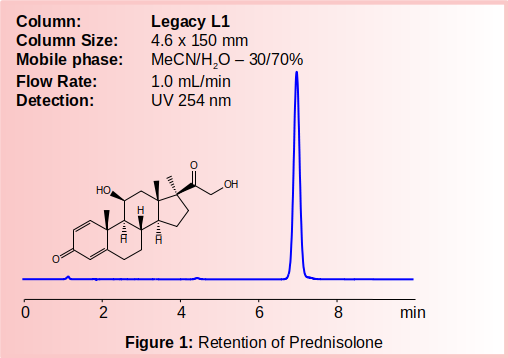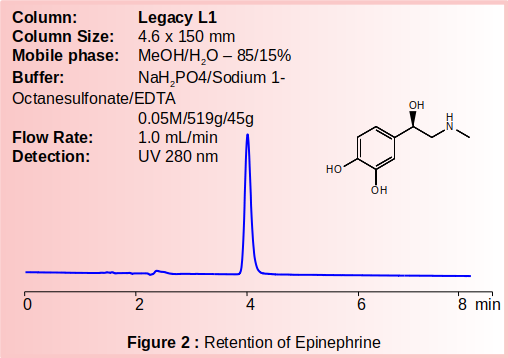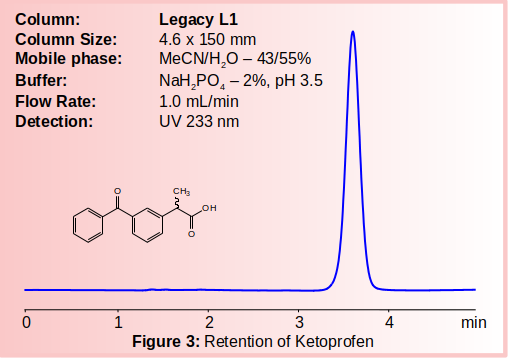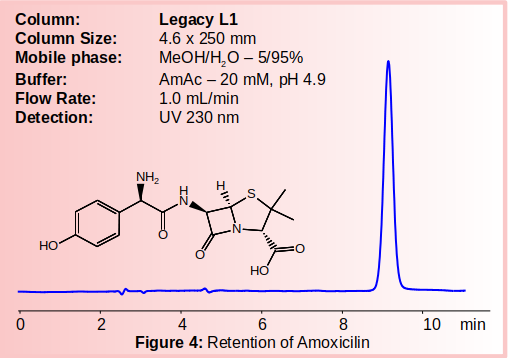The Legacy L1 column is a silica-based, single-mode reversed-phase C18 column that meets the USP qualifications for the L1 designation. Compounds are retained based on their hydrophobic interactions with the ligands. The chromatograms in this section, as well as the others, show injections done according to USP standard methods for the given compounds, with modifications to the methods noted where applicable.
Legacy L1 columns are available in all standard dimensions.
Column IDs: 22 mm, 10 mm, 4.6 mm, 3.2 mm, 2.1 mm, 1 mm, 0.5 mm, 0.25 mm
Column Lengths: 250 mm, 150 mm, 100 mm, 50 mm, 25 mm, 10 mm
Particles: 5 um
Pores: 100 A
If you would like to learn more about SIELC’s line of Legacy columns, you can download the brochure here.

Prednisolone is an artificial corticosteroid that is used to treat many chronic ailments, such as colitis, multiple scelerosis, and arthritis. Figure 1 shows retention of Prednisolone on a Legacy L1 column with a mobile phase (MP) of 30% Acetonitrile (MeCN) and 70% water.

Epinephrine, or adrenaline, is a naturally-occurring corticosteroid. In the pharmaceutical industry, it is used to treat severe allergic reactions, heart attacks, and asthma. Figure 2 shows retention of Epinephrine on a Legacy L1 column with a mobile phase mostly consisting of methanol (MeOH) and water, with NaH2PO4, Sodium 1-Octanesulfonate, and EDTA as buffers.

Ketoprofen is a nonsteroidal anti-inflammatory drug (NSAID) used frequently to help treat arthritis-related pain and gum inflammation caused by severe toothaches. Figure 3 shows retention of Ketoprofen on a Legacy L1 column with a mobile phase consisting of water and acetonitrile and a high concentration of monosodium phosphate (MSP, NaH2PO4).

Amoxicillin is common antibacterial drug derived from penicillin. Figure 4 shows retention of Amoxicillin on a Legacy L1 column with a mobile phase consisting of methanol and mostly water with ammonium acetate as the buffer.

Legacy L1 column meets the USP definition with a stationary phase that consists of octadecyl silane chemically bonded to porous silica or ceramic particles (1.5 to 10µm).
Legacy L1 columns are available in all standard dimensions.
Column IDs: 22 mm, 10 mm, 4.6 mm, 3.2 mm, 2.1 mm, 1 mm, 0.5 mm, 0.25 mm
Column Lengths: 250 mm, 150 mm, 100 mm, 50 mm, 25 mm, 10 mm
Particles: 5 um
Pores: 100 A
If you would like to learn more about SIELC’s line of Legacy columns, you can download the brochure here.

USP Methods for the Separation of Propranolol and Procainamide using a Legacy L1 Column
USP Methods for the Analysis of Pyridoxine for the Legacy L1 Column
USP Methods for the Analysis of Prednisolone with the Legacy L1 Column
USP Methods for the Analysis of Ibuprofen Using Legacy L1 Column
USP Methods for the Analysis of Naproxen Using Legacy L1 Column
USP Methods for the Analysis of Guaifenesin Using a Legacy L1 Column
USP Methods for Chloramphenicol using a Legacy L1 Column
USP Methods for the Analysis of an Analgesic Mixture Using the Legacy L1 Column
USP Methods for the Analysis of Hydrocortisone on a Legacy L1 Column
USP Analysis of Dopamine Using a Legacy L1 column
USP Analysis of Albuterol Using a Legacy L1 Column
USP Methods for the Analysis of Aspirin Using Legacy L1 Column
USP Methods for the Analysis of Epinephrine Using the Legacy L1 Column
USP Methods for the Separation of Propranolol and Procainamide using a Legacy L1 Column
USP Methods Analysis of Procainamide Legacy L1 Column
USP Methods for the Analysis of Amitriptyline using a Legacy L1 Column
USP Method for the Analysis of Amoxicillin using the Legacy L1 Column
USP Methods for the Analysis of Atenolol using the Legacy L1 Column
USP Methods for Nitrofurantoin for the Legacy L1 Column
USP Methods for the Analysis of Pyridoxine for the Legacy L1 Column
USP Methods for the Analysis of Prednisolone with the Legacy L1 Column
USP Methods for the Analysis of Niacin with the Legacy L1 Column
USP Methods for the Analysis of Praziquantel using the Legacy L1 Column
USP Methods for the Analysis of Norepinephrine using the Legacy L1 Column
USP Methods for the Analysis of Aminocaproic Acid using the Legacy L1 Column
USP Methods for the Analysis of Caffeine using the Legacy L1 Column
USP Methods for the Analysis Ketoprofen using the Legacy L1 Column
